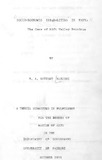| dc.description.abstract | This thesis is about the emergence and
development of socio-economic inequalities in
Kenya. It mainly deals with the role of land
as a factor of economic exploitation by the
European settler capitalism. It also deals with
African cheap labour as the exploited factor of
the newly introduced colonial capitalism. The
study therefore deals ,with the supplanting of the
African traditional socio-economic systems by
European capitalism and related oppressive
government machinery. As such, it becomes a
study of white settlement and alienation of the
African land owners, Nakuru District in rift
Valley Province is used as a case study to
demonstrate the development of inequalities from
the precolonial times to the post-independence
period.
The study begins with a brief look at some
of the ideas of the subject of socio-economic
inequalities. These include the Marxist and
weberian ideas, and also the more recent ideas
on the role of international capital in the so
called "Third world".
African traditional socio-economic systems
are briefly examined as a prelude to establishment
of colonialism which extended capitalist exploitation
to foreign lands. These included the Ndorobo (Dorobo),
the Masai, the Nandi, and the Kikuyu. All these
except the Kikuyu were found in or around the
Nakuru District on the eve of European occupation
of the district. The Kikuyu are included as they
constituted the greatest majority of the African
migrants into the area durlng the colonial (and
to a great extent during the post-independence)
period. The extent to which these societies
were egalitarian and communal is analyzed in
relation to the destruction that they later
suffered under colonial capitalist subjugation
and exploitation.
The basis and the process of land alienation
by European settlers under the umbrella of
British Government in Britain and its agents in
Kenya becomes a crucial part of the thesis. This
part coincides with the colonial period. It
includes the various methods used by the European
settlers in order to obtain cheap or free land
and labour for them to exploit. Resistance by
Africans from being converted into wage labourers
for the benefit of the capitalist Europeans is
also observed.
The 'next part of the thesis deals with the
transfer of the cushite Highlands" to Africans and
it coincides with the independence period. The ,
role of international capital in the process of
the transfer of land from the European settlers
is noted especially in its relationship with the
adoption of European capitalism by the new African
government and the cooperation between the European
capitalists and the new African ruling petty-bourgeoisie.
The objective was to involve the new African
petty-bourgeoisie in the exploitation of the rest
of the Africa masses. The petty-bourgeoisie is
in this exercise engaged as an instrument of
international capitalist exploitation of the
Kenyan masses. As will be observed this is
achieved from two fronts: a) from the foreign aid
and grants; b) from foreign investments, especially
by the multinationals.
The last part of the study deals with the
implications of continued capitalist oppression
and exploitation in Kenya after independence. The
role of the African petty-bourgeoisie in this
oppression and exploitation of the Kenyan masses
is further examined, especially in relation to
the kind of the struggles that may follow the
growing unemployment, inequalities and poverty
which may lead to a revolution against opppression
and exploitation. | en |

